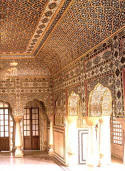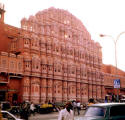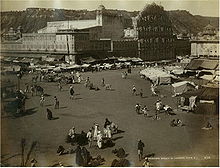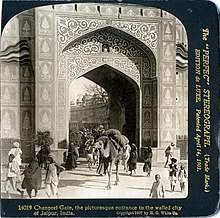Must visit places in Jaipur:
History of Jaipur:
Jaipur the capital of Rajasthan state in Indiawas founded in 1722 by Maharaj Jai Singh II, who ruled Jaipur State from 1699-1744. Initially his capital was Amber, which lies at a distance of 11 km from Jaipur. He felt the need of shifting his capital city with the increase in population and growing scarcity of water. Jaipur is the first planned city of India and the King took great interest while designing this city of victory. He consulted several books on architecture and architects before making the layout of Jaipur.
Overview
After several battles with Marathas, Jai Singh was keen on the security aspect of the city. Due to this reason, he focused on his scientific and cultural interests to make a brilliant city. Being, a lover of mathematics and science, Jai Singh sought advice fromVidyadhar Bhattacharya, a Brahmin scholar of Bengal, to aid him design the city architecture. Vidyadhar referred the ancient Indian literature on astronomy, books of Ptolemy and Euclid, and discussed the plan with the King.
With a strategic plan, the construction of the city started in 1727. It took around 4 years to complete the major palaces, roads and square. The city was built following the principles of Vastu Shastra. The city was divided into nine blocks, out of which two consist the state buildings and palaces, whereas the remaining seven blocks were allotted to the public. In order to ensure the security, huge fortification walls were made along with seven strong gates.
According to that time, architecture of the town was very advanced and certainly the best in Indian subcontinent. In 1876, when Prince of Wales visited Jaipur, the whole city was painted pink to welcome him and after that Jaipur was titled ‘Pink City’. Still, the neat and broadly laid-out avenues, painted in pink provide a magical charm to the city. Jaipur is rich in its cultural and architectural beauty, which can be traced in the various historical and aesthetic places that reside in the city.
In the 19th century the city grew rapidly and became prosperous; by 1900 it had a population of 160,000. The city's wideboulevards were paved and lit with gas. The city had several hospitals. Its chief industrieswere in metals and marble, fostered by aschool of art founded in 1868. The city also had three colleges, including a Sanskritcollege (1865) and a girls' school (1867) initiated under the reign of the enigmatic Maharaja Sawai Ram Singh II. There was also a wealthy and enterprising community of native bankers, particularly the Jains and theMarwaris.
How To Reach Jaipur
People from all parts of the world come to observe the beauty and to know about cultural legacy of Jaipur. Being the major city of the country, Jaipur is well connected to almost every corner of India via different means of public transport including air, rail and road. Every day the public transport is used by over millions of travellers travelling to and around Jaipur with various purposes and destinations. Jaipur International Airport is located about 7-10 km from the main city and can easily be reached with ease by taxi or bus. The Indian Railways on the other hand provides the best service to the passengers and as for the bus service, the roads and the highways are very well constructed and smooth with less chances of getting any dump in between the way. Read to know more about how to reach Jaipur.
By Air
The Jaipur Airport is situated at Sanganer, 7 km (domestic terminal) and 10 km (international terminal) from the main city. It connects the city to all the major parts of India as well as some of the major overseas countries. It has the facility of daily domestic flights to Delhi, Jodhpur, Udaipur, Aurangabad, Hyderabad, Goa, Kolkata, Chennai, Ahmedabad, Mumbai, Bangalore, Indore and Pune. Also, it has the facility of international flights through which it connects directly to Sharjah, Muscat and Dubai. Flights to Singapore and Bangkok are also available via Delhi. Furthermore, it offers the chartered service to London and Dublin. Once you get down at the airport, hire a taxi or take a bus to reach the main city.
By Train
Jaipur is well connected to almost every part of India through the means of Indian Railways. There are several trains which connect this city to Delhi, Mumbai, Ahmedabad, Agra, Kota, Alwar, Jodhpur, Alwar, Ajmer, Kota, Chittorgarh, Bikaner, Udaipur, Barmer, Jammu, Bikaner, Jaisalmer, Kolkata, Ludhiana, Pathankot, Haridwar, Indore, Gwalior, Bhopal, Jabalpur, Roorkee, and Kanpur. In addition to this, long-distance trains arrives from several other cities including Patna, Ranchi, Lucknow, Allahabad, Vadodara, Banaras, Surat, Bilaspur, Nagpur, Raipur, Puri, Bhubaneswar, Bangalore, Chennai, Hyderabad, Mysore, Mangalore, Goa, Kochi, and Kozhikode. There are three main railway junctions including Jaipur, the main station; Gandhinagar and Durgapara. Every train stops at Jaipur junction and a few of the trains stop at Gandhinagar and Durgapara. After getting down at the railway station, take an auto-rickshaw, bus or hire a taxi to reach the destination within the city. There is a special, luxurious and renowned train called as Palace on Wheels which departs from Delhi and connects all the well known destinations of Rajasthan including Jaipur, Jhalawar, Jodhpur, Alwar, Udaipur, etc.
By Road
Jaipur, the pink city is linked with the all the major cities of India through the network of National Highways 8, 11 and 12 to name a few. There's also a very good bus service between Jaipur and Delhi provided by Rajasthan State Road Transport Corporation (RSRTC) with the buses at about every half an hour to and from both sides. There are non-AC and AC Volvo buses in which the fare of the AC bus is more. From Jaipur you can board the bus from Narayan Singh Circle or the main Sindhi Camp bus stand whereas in Delhi you can take the bus from Bikaner House on Pandara Road which is next to India Gate. Also, there are some private buses which are available from Dhaula Kuan in Delhi. There are some express buses which connect various cities and towns of Rajasthan such as Bundi, Kota, etc. to Jaipur. This city is also connected to Mumbai via Ajmer, Ahmedabad, Udaipur and Vadodara and is also well linked to Agra via bus.
By Air
The Jaipur Airport is situated at Sanganer, 7 km (domestic terminal) and 10 km (international terminal) from the main city. It connects the city to all the major parts of India as well as some of the major overseas countries. It has the facility of daily domestic flights to Delhi, Jodhpur, Udaipur, Aurangabad, Hyderabad, Goa, Kolkata, Chennai, Ahmedabad, Mumbai, Bangalore, Indore and Pune. Also, it has the facility of international flights through which it connects directly to Sharjah, Muscat and Dubai. Flights to Singapore and Bangkok are also available via Delhi. Furthermore, it offers the chartered service to London and Dublin. Once you get down at the airport, hire a taxi or take a bus to reach the main city.
By Train
Jaipur is well connected to almost every part of India through the means of Indian Railways. There are several trains which connect this city to Delhi, Mumbai, Ahmedabad, Agra, Kota, Alwar, Jodhpur, Alwar, Ajmer, Kota, Chittorgarh, Bikaner, Udaipur, Barmer, Jammu, Bikaner, Jaisalmer, Kolkata, Ludhiana, Pathankot, Haridwar, Indore, Gwalior, Bhopal, Jabalpur, Roorkee, and Kanpur. In addition to this, long-distance trains arrives from several other cities including Patna, Ranchi, Lucknow, Allahabad, Vadodara, Banaras, Surat, Bilaspur, Nagpur, Raipur, Puri, Bhubaneswar, Bangalore, Chennai, Hyderabad, Mysore, Mangalore, Goa, Kochi, and Kozhikode. There are three main railway junctions including Jaipur, the main station; Gandhinagar and Durgapara. Every train stops at Jaipur junction and a few of the trains stop at Gandhinagar and Durgapara. After getting down at the railway station, take an auto-rickshaw, bus or hire a taxi to reach the destination within the city. There is a special, luxurious and renowned train called as Palace on Wheels which departs from Delhi and connects all the well known destinations of Rajasthan including Jaipur, Jhalawar, Jodhpur, Alwar, Udaipur, etc.
By Road
Jaipur, the pink city is linked with the all the major cities of India through the network of National Highways 8, 11 and 12 to name a few. There's also a very good bus service between Jaipur and Delhi provided by Rajasthan State Road Transport Corporation (RSRTC) with the buses at about every half an hour to and from both sides. There are non-AC and AC Volvo buses in which the fare of the AC bus is more. From Jaipur you can board the bus from Narayan Singh Circle or the main Sindhi Camp bus stand whereas in Delhi you can take the bus from Bikaner House on Pandara Road which is next to India Gate. Also, there are some private buses which are available from Dhaula Kuan in Delhi. There are some express buses which connect various cities and towns of Rajasthan such as Bundi, Kota, etc. to Jaipur. This city is also connected to Mumbai via Ajmer, Ahmedabad, Udaipur and Vadodara and is also well linked to Agra via bus.
 CITY PALACE AND S.M.S. II MUSEUM - situated in the heart of the old City, it occupies about one seventh of the old city area. The palace is a blend of Rajput and Mughal architecture, it houses a Seven storeyed Chandra Mahal in the centre, which affords a fine view of the gardens and the city. Diwan-E-Am (Hall of public audience) has intricate decorations and collection of manuscripts, Diwan-E-Khas (Hall of private audience) has a marble pawed gallery Mubarak Mahal has a rich collection of costumes and textiles. There is a Clock Tower near Mubarak Mahal. Sileh Khana has a collection of armory and weapons. Timing 9.30 to 16.45 hrs. Entry Fee for Indians Rs. 35.00 and for foreigners Rs.150.00 inclusive of entry to Jaigarh fort, Phone: 2608055
CITY PALACE AND S.M.S. II MUSEUM - situated in the heart of the old City, it occupies about one seventh of the old city area. The palace is a blend of Rajput and Mughal architecture, it houses a Seven storeyed Chandra Mahal in the centre, which affords a fine view of the gardens and the city. Diwan-E-Am (Hall of public audience) has intricate decorations and collection of manuscripts, Diwan-E-Khas (Hall of private audience) has a marble pawed gallery Mubarak Mahal has a rich collection of costumes and textiles. There is a Clock Tower near Mubarak Mahal. Sileh Khana has a collection of armory and weapons. Timing 9.30 to 16.45 hrs. Entry Fee for Indians Rs. 35.00 and for foreigners Rs.150.00 inclusive of entry to Jaigarh fort, Phone: 2608055 JANTAR MANTAR(Observatory) - built in 18th century by Maharaja Sawai Jai Singh II, the huge masonary instruments were used to study the movement of constellations and stars in the sky. Enormous sun-dial still provide accurate time, which are subject to daily corrections. Timing 9.00 to 16.30 hrs, Entry Fee Rs. 10.00, Phone: 2610494
JANTAR MANTAR(Observatory) - built in 18th century by Maharaja Sawai Jai Singh II, the huge masonary instruments were used to study the movement of constellations and stars in the sky. Enormous sun-dial still provide accurate time, which are subject to daily corrections. Timing 9.00 to 16.30 hrs, Entry Fee Rs. 10.00, Phone: 2610494 HAWA MAHAL - built in 1799, by Maharaja Sawai Pratap Singh, is the most recognizable monument of Jaipur. The 5 storied stunning semi-octagonal monument having 152 windows with over hanging latticed balconies is a fine piece of Rajput architecture. Originally designed for the royal ladies to watch and enjoy the processions and other activities, on the street below. Now it houses a well laid out museum. The display Jaipur past and present is the special feature of this newly setup museum. Timing 10.00 to 16.30 hrs, Entry Fee Rs. 5.00: Phone: 2618862
HAWA MAHAL - built in 1799, by Maharaja Sawai Pratap Singh, is the most recognizable monument of Jaipur. The 5 storied stunning semi-octagonal monument having 152 windows with over hanging latticed balconies is a fine piece of Rajput architecture. Originally designed for the royal ladies to watch and enjoy the processions and other activities, on the street below. Now it houses a well laid out museum. The display Jaipur past and present is the special feature of this newly setup museum. Timing 10.00 to 16.30 hrs, Entry Fee Rs. 5.00: Phone: 2618862 JALMAHAL - (6 kms) on the way to Amer, this small palace is set in the middle of Man Sagar Lake. A paved causeway leads upto the beautiful water palace.
JALMAHAL - (6 kms) on the way to Amer, this small palace is set in the middle of Man Sagar Lake. A paved causeway leads upto the beautiful water palace. JAIGARH FORT - (15 kms.) standing on a hilltop, overlooking the palaces and city of Amer. The world biggest cannon on wheels- the Jai Ban is positioned here, built during reign of Maharaja Sawai Jaisingh. It has a twenty feet long barrel and pumped in the cannon for a single shot. Timing 10.00 to 16.45 hrs, Entry Fee for Indians Rs. 15.00 & for foreigners Rs. 20.00, Phone: 2630848
JAIGARH FORT - (15 kms.) standing on a hilltop, overlooking the palaces and city of Amer. The world biggest cannon on wheels- the Jai Ban is positioned here, built during reign of Maharaja Sawai Jaisingh. It has a twenty feet long barrel and pumped in the cannon for a single shot. Timing 10.00 to 16.45 hrs, Entry Fee for Indians Rs. 15.00 & for foreigners Rs. 20.00, Phone: 2630848 AMER - The old capital of the Kachhwahas stands atop a range of craggy hills. The fort is remarkable as much for the majestic grandeur of its surroundings as for its sturdy battlements and beautiful palaces. It is a fine blend of Hindu and Muslim architecture. The solemn dignity of it red sandstone and white marble pavilions, when reflected in the lake at the foot hill, is a sight to behold. The original palace was built by Raja Man Singh, the additional extensions were built by Maharaja Mirja Raja Jai Singh and Sawai Jai Singh lIthe last Maharaja of Amer, who built a new city called Jaipur, where he shfted his capital in 1727.
AMER - The old capital of the Kachhwahas stands atop a range of craggy hills. The fort is remarkable as much for the majestic grandeur of its surroundings as for its sturdy battlements and beautiful palaces. It is a fine blend of Hindu and Muslim architecture. The solemn dignity of it red sandstone and white marble pavilions, when reflected in the lake at the foot hill, is a sight to behold. The original palace was built by Raja Man Singh, the additional extensions were built by Maharaja Mirja Raja Jai Singh and Sawai Jai Singh lIthe last Maharaja of Amer, who built a new city called Jaipur, where he shfted his capital in 1727.The palace complex is lavishly ornamented and displays the riches of Amer. Sheesh Mahal chamber of Mirrors. Diwan-e-Am or the Hall of Public Audience is a beautifully proportioned hall open on three sides and stands on two rows of ornamented pillars. Diwan e-Khas or the Hall of Private Audience has delicate mosaic work in glass. Sukh mandir is guarded by sandalwood doors inlaid with ivory. Throughout the massive fort finely carved lattice windows, exquisitely painted doorways, halls and finely sculptured pillars crave for attention.
The old city of Amer was the seat of power and bustling with life and prosperity. Other worth seeing sites are Jagat Shiromani Temple, Narsinghji temple, the stepwell of Panna Meena and fine carved royal cenotaphs on the road to Delhi. Timing: 9.00 to 16.30 hrs. Entry Fee For Indians Rs. 10.00, For Foreigners Rs. 50.00, Phone: 2530293, Elephant ride charge Rs. 400.00 (inclusive of all taxes) Timing : 8.00 to 16.00 hrs, Phone: 2530264 (Tourist Office).
 NAHARGARH FORT - (15 kms.) cresting a hill about 600 ft. above the city, the fort was built in 1734. The walls of the fort run along the ridge and within are architectural beauties like Hawa Mandir and Madhvendra Bhawan. Timing 10.00 to 16.00 hrs, Entry Fee Rs. 5.00, Phone: 5148044
NAHARGARH FORT - (15 kms.) cresting a hill about 600 ft. above the city, the fort was built in 1734. The walls of the fort run along the ridge and within are architectural beauties like Hawa Mandir and Madhvendra Bhawan. Timing 10.00 to 16.00 hrs, Entry Fee Rs. 5.00, Phone: 5148044 CENTRAL MUSEUM - situated in the Ram Niwas Garden. This graceful building was founded in 1876 by Prince Albert (also known as Albert Hall). It has a rare collection of archaeological and handicraft pieces. Timing 10.00 to 16.30 hrs, Entry Fee for Indians Rs. 5.00, for foreigners As. 30.00, Phone: 2570099
CENTRAL MUSEUM - situated in the Ram Niwas Garden. This graceful building was founded in 1876 by Prince Albert (also known as Albert Hall). It has a rare collection of archaeological and handicraft pieces. Timing 10.00 to 16.30 hrs, Entry Fee for Indians Rs. 5.00, for foreigners As. 30.00, Phone: 2570099BIRLA PLANETARIUM - It offers unique audio-visual education about stars and entertainment with its modern computerised projection system. Entry fee As. 20.00 show timings: 11.00, 13.00, 15.00, 17.00, 18.00, 19.00 hrs. Phone: 2381594
LAXMI NARAYAN TEMPLE - is situated just below the Moti doongri, known for the intricate marble carvings in white marble, popularly known as Birla Temple.
KANAK VRINDAVAN - (6.5 Kms on the way to Amer) This newly restored temple and garden, near Jal Mahal, has beautiful gardens and is popular picnic place. This is also beautiful location for film shooting. Entry fee Rs. 4.00 & Timings 8.00 to 17.00 hrs, Phone: 2634596









1 comment:
It is a nice article. Thanks for sharing valuable information about Jaipur tourist places. Jaipur is the best tourist spots in India. You can visit many tourist places in Jaipur like Jantar Mantar, Amer Fort, Nahargarh Fort, Birla Temple, Jal Mahal, Jaigarh Fort, Hawa Mahal, etc. Royal Adventure tour provides Jaipur Tour Package at low cost.
Post a Comment